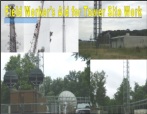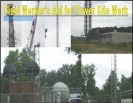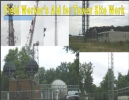Podcast: Play in new window | Download | Embed
Subscribe: Apple Podcasts | RSS
Hey small cell fans! I was recently looking over what has been holding carriers back for outdoor small cell deployment. I will lay it out for you. But first, a quick overview.
Search on iTunes for Wade4wireless and write a review now! Listen please!
I know that many people I have talked to are looking to get into small cell deployment. Many of you have already started some indoor installations. This is great! Inside building installations are a good place to start because of the small cell experience. The great thing about buildings is that you are mostly running CAT5 to the small cell. You may need to get creative and pay attention to the cable runs. Remember that core drilling is very expensive.
- First, let me describe the small cell options.
- Stand alone small cells that would be an all in one unit, it may or may not have the antenna attached to it but the controller and radio would all be in one box. If the antenna is remote then it may have the RF jumper connecting the small cell to the antenna.
- Then there are some that have a controller somewhere, like the broadband unit on a macro cell, and then connects to the radio via CAT5 or fiber. The remote radio head will be a smaller unit and will need power, wither from an outlet, from the controller, or from a router via CAT5. The controller probably controls several remote radio heads, and may control them a direct connection or through the network.
For indoor, stadiums, arena, or another controlled smaller venue you could use either one, because it is usually in a controlled environment. For street coverage in a city chances are real good that you would want the standalone unit because of real estate on a pole or in a cabinet that you’re mounting to. For these options DAS is really going to benefit from the small cell options. They still like to have some more power, I mean higher that 1 watt, but they are going to be able to control much more of the power distribution using these units.
- So what has been holding back deployments?
- Is it the price of a small cell? No, the cost of the small cells is very reasonable, cheap in fact, compared to a macro or even a microwave link.
- Is it the antenna, cable, hardware, parts, and pieces? No, much more cost-effective because it is so much smaller.
- Is it the rent? Probably not, because leasing on a pole is much more reasonable.
- Power? Maybe, smaller circuits but if you need to install power, even the minimum 100A or 200A service, whatever the local zoning permits, it will cost money.
- Is it the prep work? Like site acquisition and site surveys? It could be. This may entail a lot of prep work. It may need structural drawings on a pole, power planning, backhaul planning, site survey, and more. I will explain below.
- It is not the cost of the install, although the carriers seem to attack the installers because it is something they feel they can control and beat down. It may still take a bucket truck to do the deployments, but in the grand scheme of things, compared to a macro it is very reasonable if it is planned out properly. Planning is the key for efficiency and saving money.
- Design, integration, and optimization? It is not the design or the integration or even the optimization, but they will hammer that down to because anything that is a service is something they can beat down. Design and integration can mostly be done remotely and optimization is something that is happening anyway.
So what is it? It appears to be the backhaul. They seem to think that they need >100Mbps fiber at every small cell. Does this make sense? It might! They may need more bandwidth at some sites than others but these stand alone sites probably don’t need anything near what they have at an arena. But the carrier would know better than I would because they have Per Call Measurement Data, (PCMD) that they get and put into a tool to determine where they need coverage based on weak signal and loading. I have to tell you, they don’t really seem worried about weak signal unless it affects a major customer. So the 3G small cells never really took off, did they? The 4G LTE small cells are all about bandwidth and data, so that may be a game changer. Carriers are worried that VoLTE may not be great if they don’t have decent bandwidth. They are also looking at the constraints in the bandwidth they are allocated by the FCC, so they will need to create smaller cells to help target larger data customers. This is something they are already trying to figure out.
Do they really need 100Mbps at a small cell? Who is going to use this thing? Is it something that businesses will rely on for watching video or will you be downloading your movies from these things? Maybe someday, but to get things rolling they should look at all of the options. To put in fiber at every site is quite a bit of money, but once it’s in they never have to go back to configure it again.
So who would need high bandwidth? Any venue like a sports venue – where fans would want to look at video, listen to audio, and share anything going on at the game. No matter what the game is the arena or stadium will have crazy heavy usage. Insane usage! Perhaps at certain businesses or in some malls. Maybe on special streets like Times Square in NYC where a massive amount of people gather every New Years Day. So it makes sense to put high bandwidth backhaul and any location like that.
What about the street coverage that is there so people don’t have a dead zone or a place there customers may need coverage for their business? I don’t think they need 100Mbps but the carriers would know better than I would. This is someplace that they could plan to scale up as needed.
So, back to my point – do they need this at fiber every small cell site? I don’t think so. I think that the hybrid solutions will be the way to go to start out. They could put fiber in a site that has fiber, saving cost on installation and site acquisition. This may be a building where they could use wireless backhaul to shoot down to poles, bus stops, other building, whatever. Wireless could be E-band licensed point to point (PTP), 5.8GHz point to multi point (PTMP), or another solution. I think that the traditional licensed bands, like 18GHz or 23GHz may not be feasible due to bandwidth and physical constraints. You will need something small and easy to deploy.
I think that the PTMP may be a quick solution but it’s in the 5.8GHz shared band. This means that anyone could interfere with you at any time causing serious degradation to your link at any time, and there is little you can do about it. It is cheap, comparatively speaking, and easy to deploy. The bandwidth you get may range from a few Mbps to >20Mbps that I am aware of. This varies but realistically I would not expect much more than this. Vendor dependant. Distance could be an issue and depends on what you are trying to achieve, but I would not recommend going too far, over a mile, just to keep your reliability as high as possible. Again, look over your design, know your OEM, and understand the plan for growth.
The E band solution in the 70 to 80 GHz bands. They have a 60GHz band solution as well. This does need to be licensed but they call it light licensing because it is quick and easy and the link distance is very short, under a mile in almost all cases. It does however, based on design and distance, allow you to pass up to 1GHz of bandwidth between links. It must be line of site (LOS) and weather is a factor. It all has a price!
I think that the hybrid solution of using both wireless and fiber may be the best way to go. When you look at putting fiber at every site it could not be cost-effective. However, if you put fiber there from day one you may never need to go back to upgrade. So the design and growth plan is so important. If you don’t see much growth in an area, then why put the money into it up front? I think there are already many business models to look at cost-effective alternatives.
Some carriers want fiber everywhere without any type of reference. What I see is a team of people who do a great job building out a Macro site trying to find synergies with the small cells. However, on backhaul requirements, you have a large area to cover, 3 to 12 sectors, and real loading with many customers at any given time. On the small cell, outside of a sports arena, you may cover 10 to 50 users, realistically, at one time. It may go up to 128 to 256 is this is a busy area. Will they all be using heavy bandwidth, probably not, but it is still loading.
What can you do as a deployment team? Make sure you understand the needs of the customer. Chances are good that they will need site surveys done prior to deployment as part of with the RF design and site Acquisition. When you do the site survey make sure you are aware of all obstacles. You can make sure you understand where the fiber is located. They should have fiber maps showing where the rings are. Maybe you would recognize that a building would be a better fit than a pole because you could set it up as a hub then connect the surrounding poles using wireless backhaul. Look for obstructions that would block wireless backhaul. Maybe you know where the macro site is and that could be the hub and connect to it directly with wireless backhaul. However, most of this may be wishful thinking and there may not be any path back to anything if the customer does installations across a huge area and not a planned organized deployment.
Remind the customer of the cost savings of planning mass deployments in one area. That is something to make clear, if they do single installations all over a wide area, then there are no savings on installation. If they plan it out very well in one area and do 10 installations in one city or metro area, then they will see installation savings.
Be open to suggest idea to help. If you get the site survey work then you are in an excellent position to offer advice. I won’t’ guarantee that they will take it, but hey, you tried to help.
Let me put the budget into perspective for you. To run fiber, even 100 feet it may cost up to $30K or more, all depending what is involved. Underground will involve trenching, permitting, maybe a planned road closure, or more. Overhead may be cheaper, but I am not a fiber guy, they would know better than I would. If you purchase radios they may be $10K and up, but once you mount it then it should work for a very long time assuming it is of good quality and the installation was done properly. You always have cable modems that would connect you to the internet and the carrier would have to build a VPN tunnel to keep it up, I think this may be the cheaper route up front but then you have the monthly OPEX.
So it will not be cheap or free no matter what they do. So it is up to you in the field to make sure you do all that you can to assist them to make the right decisions. Help them out by offering advice to how they could deploy, after all, you are on the front line and we all know that the front line is where all the good ideas come from, right? Of course! Make sure you think it through and be open to a conversation, and listen to what they are really looking for. If they determine that they need fiber at every site regardless of the cost, then so be it. Give it to them and respect their wishes. Just make sure you offer alternatives that are smart and cost-effective.
Tell me what you think!
http://www.thinksmallcell.com/
http://www.smallcellforum.org/
http://www.alcatel-lucent.com/solutions/small-cells
https://www.qualcomm.com/1000x/small-cells
My SOW training will be out next week. My big release will be soon! Make sure you tune in!
Be smart, be safe, and pay attention.
Soon I will release my training for the SOW and more, to build your library of basic knowledge so you can advance in your job and the industry! My books will help teach someone the basics of tower work.
Kindle:
PDF books so you can buy with PayPal:
PDF books you can pay with Credit Card:










